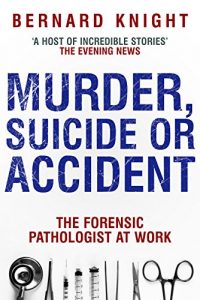What exactly does a forensic pathologist do?
Written under a pseudonym by a practising full-time forensic pathologist and ex-Home Office consultant, the “inside story” is given for the first time of this macabre, yet vital profession which contributes to keeping Britain a country with one of the lowest murder rates in the world.
However, murder, although the topic which attracts all the publicity, is the smallest part of the function of a forensic pathologist.
The major part of his work concerns the investigation of other causes of sudden death — accidents, suicides and natural disease. These pages show how the community is best served by the careful reconstruction of traffic, domestic and industrial accidents and the documentation of natural diseases which adds to the sum total of preventive medical knowledge.
In spite of the relative rarity of murder investigations, a large part of the book is devoted to details of how the pathologist goes about his examination of the scene of a crime, the identification of the victim and the interpretation of the common methods of homicide.
The author shows how specialised medical experience assists in the reconstruction of deaths, whether it be by bullet, knife or rope, and he describes the salient features of death associated with sexual crimes, abortion and infant deaths.
‘A host of incredible stories’ – The Evening News
‘The information is accurate… and readable.’ – The Pathology Review
Professor Bernard Henry Knight (born 1931) is a celebrated pathologist and author of over more than 30 novels and television scripts. After becoming a Home Office pathologist he remained in his role for 43 years, conducting over 25,000 autopsies and assisting with some of Britain’s most notorious murder cases, including the Fred and Rosemary West murders and the first cases to use DNA for evidence of identity. In 1980 he was appointed as Professor of Forensic Pathology at the University of Wales College of Medicine.
Written under a pseudonym by a practising full-time forensic pathologist and ex-Home Office consultant, the “inside story” is given for the first time of this macabre, yet vital profession which contributes to keeping Britain a country with one of the lowest murder rates in the world.
However, murder, although the topic which attracts all the publicity, is the smallest part of the function of a forensic pathologist.
The major part of his work concerns the investigation of other causes of sudden death — accidents, suicides and natural disease. These pages show how the community is best served by the careful reconstruction of traffic, domestic and industrial accidents and the documentation of natural diseases which adds to the sum total of preventive medical knowledge.
In spite of the relative rarity of murder investigations, a large part of the book is devoted to details of how the pathologist goes about his examination of the scene of a crime, the identification of the victim and the interpretation of the common methods of homicide.
The author shows how specialised medical experience assists in the reconstruction of deaths, whether it be by bullet, knife or rope, and he describes the salient features of death associated with sexual crimes, abortion and infant deaths.
Praise for Murder, Suicide or Accident:
‘A host of incredible stories’ – The Evening News
‘The information is accurate… and readable.’ – The Pathology Review
Professor Bernard Henry Knight (born 1931) is a celebrated pathologist and author of over more than 30 novels and television scripts. After becoming a Home Office pathologist he remained in his role for 43 years, conducting over 25,000 autopsies and assisting with some of Britain’s most notorious murder cases, including the Fred and Rosemary West murders and the first cases to use DNA for evidence of identity. In 1980 he was appointed as Professor of Forensic Pathology at the University of Wales College of Medicine.






